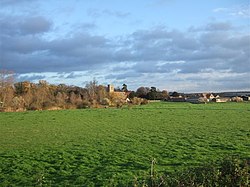Oakley, Bedfordshire: Difference between revisions
Created page with "{{Infobox town |name=Oakley |county=Bedfordshire |picture= |picture caption= |os grid ref=TL007536 |latitude=52.171497 |longitude=-0.526605 |population=2,438 |census year=20..." |
mNo edit summary |
||
| Line 2: | Line 2: | ||
|name=Oakley | |name=Oakley | ||
|county=Bedfordshire | |county=Bedfordshire | ||
|picture= | |picture=St Mary's Church, Oakley - geograph.org.uk - 288332.jpg | ||
|picture caption= | |picture caption=Oakley | ||
|os grid ref=TL007536 | |os grid ref=TL007536 | ||
|latitude=52.171497 | |latitude=52.171497 | ||
Revision as of 19:53, 22 July 2014
| Oakley | |
| Bedfordshire | |
|---|---|
 Oakley | |
| Location | |
| Grid reference: | TL007536 |
| Location: | 52°10’17"N, -0°31’36"W |
| Data | |
| Population: | 2,438 (2001) |
| Post town: | Bedford |
| Postcode: | MK43 |
| Dialling code: | 01234 |
| Local Government | |
| Council: | Bedford |
| Parliamentary constituency: |
North East Bedfordshire |
Oakley is a village in northern Bedfordshire lying along the River Great Ouse, about four miles northwest of the county town, Bedford. It has a population of around 2,500. Nearby are the villages of Bromham, Milton Ernest, Clapham, Radwell and Felmersham.
Parish church
Thee parish church is St Mary's, a mediæval church. It has a rare survival in a 15th century rood screen with mediæval painting. The font is of the Middle Ages, and the church also holds an ancient wooden chest.
History
Some of the earliest evidence of a settlement was found within the current village boundaries in the form of flint axes and arrow heads labelled OAK(ley)and EAM(cdonald), which were dated to c. 7000-6000 BC. Iron Age (c. 50 BC.) evidence was found when excavations were being undertaken for the Almshouses.
Oakley also features in the Domesday Book, which records that before the Norman Conquest the land was held by an Oswulf, a thane of King Edward the Confessor.
In 1166 AD, the lord of the manor was recorded as being one Simon de Bosard, and his brother was known to have had connections with the town now known as Leighton Buzzard. In 1200 it was recorded that the present parish church was built, replacing an earlier church built of wood in Saxon times. Nothing of this earlier church remains. In 1230 the first vicar was recorded, a Stephen de Castell. In 1278, a Richard de Bosard had no male heir, but his daughter married Thomas Reynes who took over Oakley thanks to his wife. The village was known as Oakley Reynes at least until the drafting of the 1795 pre-enclosure map. The name still appears today in "Reynes Drive". The family also owned Clifton Reynes, just over the border into Buckinghamshire. In 1331, there was another Thomas Reynes recorded.
1349 the Black Death struck the village and three vicars died in quick succession, D Walter, John Marshall and Robert Fox all perishing in that year, and perhaps half the village's population.
In 1451, John Reynes died and left no male heirs, so the village passed to the Taylard family. Again, in 1548 there were no male heirs to the Taylards, but the heiress married a Robert Brundenell, who took over. Oakley remained in the Brundenell family until 1648, when it passed to the Mordaunts.
In 1671, window tax returns record the population of Oakley as being 255 souls. In 1679 the Mordaunts sold Oakley to the Levinz family, who in their turn sold it in 1737 to the 4th Duke of Bedford, who demolished the old manor house and replaced it with that standing today.
The 7th Duke of Bedford decided to build new cottages for the Estate tenants, and these were constructed of the best materials available in order to avoid needless repairs in the future, and cottages with gardens and a water supply. The village's winding roads were straightened out and Station Road built. The High Street was straightened, as was Duck End Road, now Church Lane. All the cottages in the High Street and Station Road were built in blocks for the sake of economy, usually six to a block. Most have a stone inscription in the gable showing a ducal coronet, a letter "B" for Bedford and the date of construction. Most of the earlier homes were of stone and thatch and were demolished when the new houses became available.
A village hall was built to celebrate the Diamond Jubilee of Queen Victoria. This was paid for by the Dowager Duchess, the widow of the 10th Duke. It was situated at the end of what is now Reynes Drive. It provided the village with a reading room for meetings, entertainment, and a library. The First World War saw great change. The 11th Duke of Bedford overspent on his work for the war effort of 1914-1918, such as the military training camp he established at his own expense in Ampthill Park, and after the war was battered by Lloyd George's new tax demands. In 1918, the Oakley estate was sold at auction. Each tenant was given the opportunity of purchasing his own residence, and those who could afford it did so.
Sport
- Cricket: Pilgrims Oakley Cricket Club
- Football: Oakley FC
Outside links
| ("Wikimedia Commons" has material about Oakley, Bedfordshire) |
